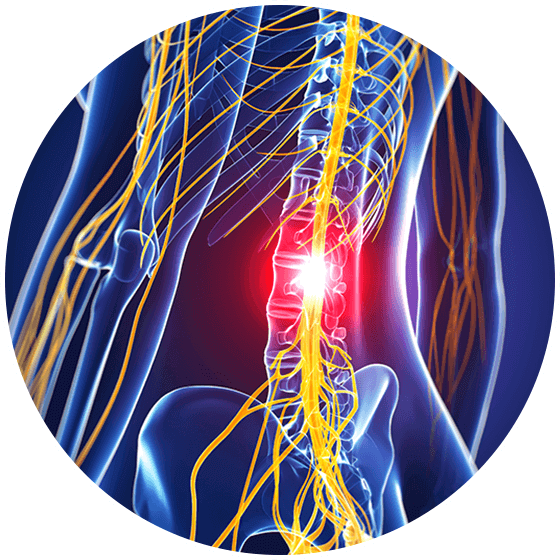Spinal Cord Injury

Spinal Cord Injury Symptoms & Treatment Options
Next to the brain itself, the spinal cord is one of the most crucial parts of our central nervous system. Without the spinal cord, the brain cannot do anything except think about doing things. None of the brain’s messages can be delivered to the body. The spinal cord runs from the stem of the brain, down the spinal column, and to the tailbone. Along the way, your spinal cord branches out into 31 pairs of nerves. These 31 nerve pairs continue branching until they have reached all corners of the body. Your spinal cord is responsible for transmitting messages from the brain to the body and then from the body back to the brain. Nerves extending from the spinal cord influence movement, reflexes, breathing, heartbeat, and other crucial functions, such as bowel and bladder control.
The term spinal cord injury refers to any trauma that results in damage to the spinal cord. This can occur to any segment of the spine. And, the resulting damage can cause differing consequences based on the severity and location of the injury. The injury can either partially or completely block communication between the brain and the body. This can result in anywhere from minor to major complications in an individual’s typical functioning. Likewise, the effects of an injury can also vary depending on the site of the injury. Cervical spinal cord injuries, for example, result in different symptoms than thoracic spinal cord injuries.
Common Causes of Spinal Cord Injuries
Responsible for over half of all spinal cord injuries reported, one of the main causes of spinal trauma results from motor vehicle accidents. Other traumatic events, such as physical violence or assaults, are common sources of spinal cord injury. Additionally, sports injuries and falls can also cause instantaneous injury to the spinal cord.
Compression of the spinal cord from degenerative disorders or spinal disease can also cause injury. Conditions such as tumors, bone spurs, or spinal stenosis can progress in severity until the function of the spinal cord is permanently damaged.
Furthermore, a lack of blood supply to the spinal cord can also result in permanent disruption. Aneurysms, blocked arteries, and chronic low blood pressure can deprive the spinal cord of its blood supply, causing irreversible harm.
Symptoms will vary according to the site and severity of the injury, symptoms of a spinal cord injury may include:
Full or partial loss of movement in the arms, legs, and/or trunk of body
Loss of sensation, such as the inability to feel temperature or pressure
Extreme pain or the sensation of unrelenting pressure from compressed nerves
Exaggerated or uncontrolled reflexive movements, such as muscle spasms
Difficulty breathing, walking, or an unusual lack of coordination in movements
Loss of bowel or bladder control, resulting in continued incontinence
Symptoms of Spinal Cord Injury
Your spinal cord spans the entire length of your back. It’s length alone allows for many possible sites for injuries, each with their own symptoms and consequences
The list above is not an exhaustive collection of symptoms, however. The most severe cases of spinal cord injury can result in total paralysis below the point of injury. This results in conditions that we refer to as paraplegia (loss of bodily function in the lower body), tetraplegia (loss of bodily function in three limbs), and quadriplegia (loss of bodily function in all four limbs).
Here at the Advanced Spine Center, Dr. Charles A. Gatto, M.D. specializes in treating individuals with advanced cases of spinal trauma. Whether your condition requires pain management, conservative therapies, or minimally invasive surgery, Dr. Gatto and his acclaimed colleagues will work with you to establish an effective and innovative treatment plan.
Steps to Addressing Spinal Cord Injury
Depending upon the severity of your injury, different treatment methodologies will be recommended to address your pain. Often with acute spinal cord injuries, there will be an immediate trip to the emergency room following the damaging event. It is here that doctors will initially (and emergently) address the needs of the individual, inducing immobility, ensuring proper breathing, administering emergency medications to reduce inflammation, and utilizing imaging techniques to locate the exact site of injury. Emergency surgery can be used when necessary to remove any bone or other materials that are compressing the spine.
If the injury is less emergent, or occurs slowly over time, it is still important to seek immediate medical attention before the condition can worsen. Your physician will most likely obtain your full medical history, including your past family history as well as your personal medical history. In addition, your doctor will require a full account of the event that caused the trauma. Your appointment may also involve a physical examination to evaluate the location of the injury, as well as to assess any sensory effects to the extremities of the body. Finally, imaging techniques such as MRIs and CT scans will most likely be used to examine the location of the injury and assess any spinal fractures, breaks, compressions, or slips.